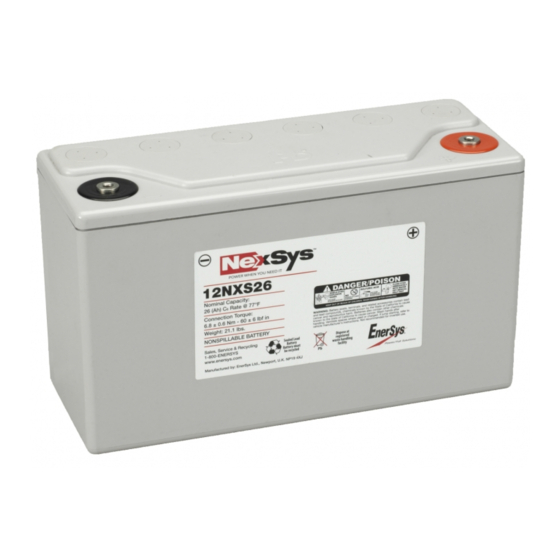
EnerSys Nexsys 12NXS26 Technical Manual
Hide thumbs
Also See for Nexsys 12NXS26:
- Operation and maintenance instructions (3 pages) ,
- Owner's manual (10 pages)
Summary of Contents for EnerSys Nexsys 12NXS26
- Page 1 Small traction motive power ® NexSys Technical Manual Designed to change the way you work...
-
Page 2: Table Of Contents
CONTENTS Introduction..............3 Safety Precautions . -
Page 3: Introduction
NexSys Technical Manual INTRODUCTION Since their introduction in the early 1990s, thin plate pure lead (TPPL) blocs have been established as a premium high performance bloc suitable for a wide range of demanding applications. Today, the TPPL technology can be found in applications as diverse as emergency power, avionics, medical, military and consumer equipment. -
Page 4: Recombination Technology
NexSys Technical Manual RECOMBINATION TECHNOLOGY How gas recombination works: When a charge current flows through a fully charged conventional lead acid cell, electrolysis of water occurs to produce hydrogen from the negative electrode and oxygen from the positive electrode. This means that water is lost from the cell and regular topping up is needed. -
Page 5: Blocs & Range Summary
59.40 M8 Female Table 1 Terminal layout 1 Terminal layout 3 Option A: SAE post Option B: M6 male front Terminal layout 2 terminal adapter Flexible connectors must be used for all monobloc connections. EnerSys® approved fasteners must be used. -
Page 6: Orientation
NexSys blocs may be configured into a bloc comprising series/parallel strings, with the maximum number of parallel strings limited to 3. It is paramount that the cable lengths within each string are equal. Only EnerSys® approved components/parts must be used in conjunction with NexSys product. STATE OF CHARGE The open circuit voltage of the individual NexSys bloc prior to installation can be used as an approximate guide to the state of charge (SOC) of the bloc. -
Page 7: Storage - Nexsys Blocs Installed In Equipment
NexSys Technical Manual STORAGE – NEXSYS BLOCS INSTALLED IN EQUIPMENT Some equipment will continue to draw very low power loads from the bloc when not in service. This results in bloc self discharge rates greater than shown in Figure 1 and described in the previous section. -
Page 8: Commissioning
20°C/68°F, after which a refresh charge should be administered. However, it is advisable to conduct an inspection and open circuit voltage check after 12 months. If the open circuit voltage falls below 12.6 volts the bloc should be recharged using an approved EnerSys® NexSys® charger. -
Page 9: Operation
The ambient temperature range of use for the bloc is between +5°C/41°F and +45°C/113°F, outside of this range must be approved by the EnerSys Technical Department. Optimal bloc life is obtained with the bloc at a temperature between 25-30°C or 77-86°F. Higher temperatures shorten the life of the bloc (according to IEC 1431 technical report), lower temperatures reduce the available capacity. -
Page 10: Discharging
Limit the discharge to 80% DOD. The presence of a discharge limiter is mandatory and cut- off voltage must be set at the value detailed in Table 4, when discharging with currents in the range of I to I . At lower currents please seek advice from the EnerSys® Application Engineering Authority. - Page 11 NexSys Technical Manual Constant Current Discharge (A) 1.75VPC @ 25°C/77°F Discharge Rate (Hr) 12NXS26 1.48 2.72 3.29 4.27 7.88 20.31 35.62 12NXS36 2.04 3.77 4.59 5.97 11.10 28.36 49.10 12NXS38 2.04 3.86 4.75 6.19 11.50 29.63 51.37 12NXS50 2.78 5.21 6.36 8.26 15.20...
-
Page 12: Charging
EnerSys® has developed a fast charge algorithm for cyclic applications to rapidly and safely charge this technology of blocs. EnerSys has a full range of chargers available that can be purchased to be used with your NexSys bloc. -
Page 13: Opportunity Charging
NexSys or NexSys+ charger. Contact EnerSys® before using rates outside this range. As another example, consider a 100Ah bloc discharged by 80Ah (to 80% Depth of Discharge), then recharged with a 0.5C5/C6 inrush current, 100% of the discharged Ah... -
Page 14: Cycle Life
NexSys Technical Manual CYCLE LIFE The life expectancy of the NexSys® bloc series depends on the application and its duty cycle. While several factors affect the life of a bloc, cycle life depends primarily on the depth of discharge (DOD). CYCLES AS A FUNCTION OF DEPTH DISCHARGE 10000 1000... -
Page 15: Disposal
NexSys Technical Manual DISPOSAL NexSys® blocs are recyclable. Scrap blocs must be packaged and transported in accordance with prevailing transportation rules and regulations. Scrap blocs must be disposed of in compliance with local and national laws by a licensed or certified lead acid bloc recycler with these attributes. - Page 16 Tel +65 6508 1780 Fax: +65 6292 4380 www.enersys.com Section 25.10 Revision 06/18. © 2018 EnerSys. All rights reserved. Trademarks and logos are the property of EnerSys and its affiliates unless otherwise noted. Subject to revisions without prior notice. E.&O.E.

















Need help?
Do you have a question about the Nexsys 12NXS26 and is the answer not in the manual?
Questions and answers
What is the charging voltage and amp for 12nxs166 battery
The exact charging voltage and amp for the EnerSys 12NXS26 battery are not specified directly in the provided context. However, it must be charged using an EnerSys-approved charger with the appropriate NexSys® TPPL charging profile. For discharge, the cut-off voltage is 1.75 V per cell at 25°C (77°F) and 1.70 V per cell at 30°C (86°F). Charging current details are not included.
This answer is automatically generated